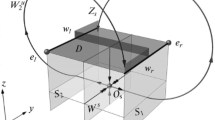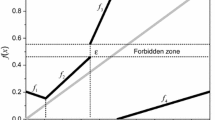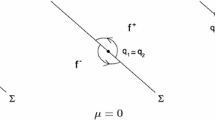Abstract
We study the dynamics of a one dimensional discontinuous linear-power map. It has a vertical asymptote giving rise to new kinds of border collision bifurcations. We explain the peculiar periods of attracting cycles, appearing due to cascades of alternating smooth and nonsmooth bifurcations. Robust unbounded chaotic attractors are also described.
Access provided by CONRICYT-eBooks. Download conference paper PDF
Similar content being viewed by others
1 Introduction
The large number of applied models characterized by sharp switching between different states are ultimately described by nonsmooth systems. One of the efficient methods to investigate the dynamics of such systems is related to the construction of a first return map on some Poincaré section of the phase space, leading to piecewise smooth (PWS for short) maps, continuous or discontinuous. In particular, in engineering the well known Nordmark systems associated with grazing bifurcations (see [5, 6]) have been studied using PWS return maps with power function nonlinearities. The present study deals with a particular case of such a map. It is defined by two functions, \(f_{L}(x)\) and \(f_{R}(x)\), as follows:
where a, b and \(\gamma \) are real parameters, \(\gamma >0\).
2D bifurcation diagrams of f in the (a, S(b))-parameter plane, where \(S(b)=\arctan (b)\), for \(0<\gamma <1\) in (a) and \(\gamma >1\) in (b); stripped regions are related to coexistence, colored regions to attracting cycles of different periods, uncolored region to higher periodicity or chaotic attractors, grey region to divergence. In (c) examples of map f are shown
The PWS map (1) for \(\gamma <0\) corresponding to the continuous case, has been considered by many authors; see, e.g., di-Bernardo–Budd–Champneys–Kowalczyk [1]. One of the characteristic features of map (1) is the occurrence of border collision bifurcations (BCB for short). This term denotes the collision of an invariant set, typically a periodic point, with a border at which the system function changes its definition. In the study of one dimensional continuous PWS maps, the skew tent map is used as a border collision (BC) normal form, which is a powerful analytical tool to determine the effect of the BC of a cycle of any period; see Sushko–Avrutin–Gardini [7] for a survey.
Besides \(\gamma <0\), also the case \(\gamma >0\) in which map (1) is a discontinuous map with a vertical asymptote at \(x=0\), has been recently analyzed, mainly related to the case of free terms equal to \(+1\); see [3, 4]. In the present work we consider the discontinuous map (1) and explain why peculiar cascades of alternating smooth and nonsmooth bifurcations are observed, leading to the appearance of attracting cycles of periods \(p_{i+1}=2p_i\) for odd i and \(p_{i+1}=2p_i-1\) for even i, where \(p_0=n\), \(n\ge 3\), is the period of an attracting cycle whose flip bifurcation (denoted S-flip) initiate the cascade. We show also that map (1) can possess unbounded chaotic attractors which are robust in some parameter regions and not robust in others. For all the proofs we refer to Gardini–Makrooni–Sushko [2].
A typical view of the bifurcation structure of the parameter space of f is presented in Fig. 1. In the following, after some preliminaries, we discuss first the parameter range \(a<0\), \(b<0\), associated with invertible map and, thus, with more simple dynamics. Then we consider the range \(a<0\), \(b>0\), when f is noninvertible, which we split in two subcases, for \(\gamma >1\) and \(0<\gamma <1\) related to quite different dynamics.
Bifurcation diagram a vs S(x) at \(b=-5\), where \(S(x)=\arctan (x)\). In (a) \(\gamma =0.5\), in (b) \(\gamma =2\) and in (c) \(\gamma =1\), associated with the subcritical, supercritical and degenerate flip bifurcations of the 2-cycle LR, respectively. For \(a=1\) related to DFB of \(x_L^*\) the interval \([-1,0]\setminus x^*_L\) is filled by 2-periodic points; additionally, for \(\gamma =1\) intervals \((-\infty ,-1] \setminus x_0\) and \([0,+\infty )\setminus x_1\) are filled by 4-periodic points, being associated with DFB of the 2-cycle. The value \(a_f\) is obtained by substituting \(b=-5\) and the related value of \(\gamma \) to \(b=\psi _{LR}\); see Proposition 1
2 Preliminaries. Invertible Case: \(\varvec{b}<0\)
The two partitions of the definition range of the map f are denoted as \(I_L=(-\infty ,0]\) and \(I_R=\left( 0,+\infty \right) \). To denote an n-cycle \(\{x_i\}_{i=0}^{n-1}\) of the map f, we use its symbolic representation, associating the symbol L with \(x_i \in I_L\), and R with \(x_i \in I_R\). The fixed points of f are denoted as \(x=x_L^*=1/(a-1)\in I_L\), and \(x=x_R^*\in I_R\). The fixed point \(x=x_L^*\) obviously exists for \(a<1\), being attracting for \(|a|<1\); at \(a=-1\) it undergoes a degenerate flip bifurcation (DFB for short). The fixed point \(x=x_R^*\) exists for \(b>0\); it is repelling for \(\gamma \ge 1\), while for \(0<\gamma <1\) it undergoes a subcritical flip bifurcation at
being repelling for \(0<b\le \psi _R\) and attracting for \(b>\psi _R\); see Fig. 1. The following propositions summarise the dynamics of f in the invertible case; see also Fig. 2.
Proposition 1
(Flip bifurcations of the 2-cycle LR) Let \(a<0\), \(b<0\), and \(\gamma >0\). Then the map f given in (1) has a unique 2-cycle \(\left\{ x_0, x_1\right\} \) with \(x_0<1/a<0\), \(x_1>0\), which undergoes a flip bifurcation at
for \(\gamma \ne 1\), and \(a=-1\) for \(\gamma =1\). This flip bifurcation is subcritical for \(0<\gamma <1\) and the 2-cycle is attracting for \(b<\psi _{LR}\); supercritical for \(\gamma >1\) and the 2-cycle is attracting for \(b \ge \psi _{LR}\); degenerate for \(\gamma =1\), and the 2-cycle is attracting for \(a<-1\). Moreover, as \(a \rightarrow 0_-\), the repelling 2-cycle LR disappears by a nonregular BCB at \(a=0\): \(\left\{ x_0,x_1\right\} |_{a=0}=\left\{ -\infty ,0\right\} \).
Proposition 2
(BCB of the 4-cycle) Let \(a<0\), \(b<0\), and \(\gamma >0\). Then, for the map f given in (1) at \(a=-1\), a nonregular BCB of a 4-cycle \((LR)^2\) occurs such that for \(0<\gamma <1\) a repelling 4-cycle disappears as \(a \rightarrow -1_+\); for \(\gamma >1\) an attracting 4-cycle disappears as \(a \rightarrow -1_-\); the points of the 4-cycle \((LR)^2\) at \(a=-1\) are \(\left\{ 0,-\infty ,+\infty , -1\right\} \).
3 Noninvertible Case: \(\varvec{b}>0\), \(\gamma >1\) (Periodicity Regions)
Proposition 3
(map g) Let \(b>0\) and \(\gamma >0\). Then the dynamics of the map f given in (1) are in one-to-one correspondence with the dynamics of the map g defined by three functions, \(f_L(x)\), \(f_M(x)=f^2_R(x)\) and \(f_R(x)\), as follows:
which is continuous at \(x=0\), with \(g(0)=-1\), and discontinuous at \(x=f_R^{-1}(0)\) with \(\lim _{x\rightarrow f_R^{-1}(0)_-}g(x)=+\infty \) and \(\lim _{x\rightarrow f_{R}^{-1}(0)_+}g(x)=0\).
The auxiliary map g is of help to study the dynamics of f in the noninvertible case:
Proposition 4
Let \(b>0\) and \(\gamma >1\) be fixed, and \(a\in (a^h_R,-1)\), where \(a=a^h_R\) satisfies the condition \(b=-a(-a-1)^{\gamma }\) of the first homoclinic bifurcation of \(x_R^*\). Then,
-
(i)
any fold bifurcation (either fold-BCB or S-fold) of the map g given in (2) is associated with the appearance of a pair of cycles for map f, one attracting and one repelling, whose periods differ by 1 (say n and \(n-1\));
-
(ii)
let \(x=x^*>0\) be a periodic point, closest to \(x=0\), of an attracting n-cycle of f with a negative eigenvalue, which attracts all points of the interval \((0,x^*)\), and let \(R^2\sigma _0\) be the symbolic sequence of this cycle (here, \(\sigma _0\) stands for the remaining symbolic sequence, necessarily starting with L). Then, decreasing a it is observed a cascade of alternating S-flip bifurcations and BCs leading to cycles whose symbolic sequences can be written as \(R^2\sigma _k\), where \(\sigma _k=\sigma _{k-1}T\sigma _{k-1}\), \(k=1,2,\ldots ,\) with the alternating symbols \(T=R^2\) and \(T=L\). The symbol \(T=R^2\) corresponds to an S-flip bifurcation, so that an attracting m-cycle in this cascade is followed by an attracting 2m-cycle, while the symbol \(T=L\) is associated with a BC and the m-cycle is followed by an attracting \((2m-1)\)-cycle.
For example, starting from an attracting 3-cycle, for decreasing a one observes a cascade of bifurcations leading to appearance of attracting cycles of periods 6, 11, 22, 43, ...
4 Noninvertible Case: \(\varvec{b}>0\), \(0<\gamma <1\) (Dominant Chaos)
Proposition 5
(robust unbounded chaos) Let \(0<\gamma <1\) and \(0<b\le \psi _R\). Then,
-
(i)
for \(a^h_L<a<-1\), the map f has an unbounded chaotic attractor consisting of intervals \([-1,f_R^2(-a-1)]\), \([f_L\circ f_R^2(-a-1),-a-1]\) and \([f_R(-a-1),+\infty )\); here, \(a=a^h_L\) satisfies the condition of the first homoclinic bifurcation of \(x^*_L\) defined by
$$ \frac{b}{\left( b(-a-1)^- \gamma -1 \right) ^\gamma }=\frac{a}{a-1}; $$ -
(ii)
for \(a^h_R<a\le a^h_L\) the map f has an unbounded chaotic attractor consisting of intervals \([-1,-a-1]\) and \([f_{R}(-a-1),+\infty )\);
-
(iii)
for \(a_{LR}<a\le a^h_R\), depending on the value of b, the map f may have the attracting unbounded chaotic interval \([-1,+\infty )\); here, \(a=a_{LR}\) satisfies the condition
$$ b=-\frac{1}{a\gamma }\left( -\gamma \frac{a+1}{\gamma +1}\right) ^{\gamma +1} $$of the fold bifurcation of the 2-cycle LR (indicated in Fig. 1 as \(\phi _{LR}\));
-
(iv)
for \(a<a_{LR}\) almost all the trajectories converge to the attracting 2-cycle born crossing the curve \(\phi _{RL}\), and a chaotic repeller exists.
Proposition 6
Let \(0<\gamma <1\) and \(b>\psi _R\). Then,
-
(i)
for \(a^h_L<a<-1\), the attracting fixed point \(x_R^*\) of the map f coexists with a chaotic attractor in the unbounded invariant absorbing intervals
$$ [-1,f_R^{2}(-a-1)]\cup [f_L\circ f_R^2(-a-1),-a-1]\cup [f_R(-a-1),+\infty ); $$ -
(ii)
for \(a^h_{RR}<a\le a^h_L\), the attracting fixed point \(x_R^*\) of the map f coexists with a chaotic attractor in the unbounded invariant absorbing intervals \([-1,-a-1]\cup [f_R(-a-1),+\infty );\) here, \(a=a^h_{RR}\) is related to the first homoclinic bifurcation of the repelling 2-cycle;
-
(iii)
for \(a_{LR}<a\le a^h_{RR}\), depending on the value of b, the fixed point \(x_R^*\) may be the unique attractor of the map f, and a chaotic repeller exists;
-
(iv)
for \(a<a_{LR}\), the attracting fixed point \(x_{R}^{*}\) coexists with an attracting 2-cycle born due to an S-fold crossing the curve \(\phi _{RL},\) and a chaotic repeller exists.
References
M. di Bernardo, C.J. Budd, A.R. Champneys, P. Kowalczyk, Piecewise-Smooth Dynamical Systems: Theory and Applications, vol. 163, Applied Mathematical Sciences (Springer, London, 2008)
L. Gardini, R. Makrooni, I. Sushko, Cascades of alternating smooth bifurcations and border collision bifurcations in a family of discontinuous linear-power maps, Geocomplexity Discussion Paper No.3/2016, ISSN:2409-7497, http://econpapers.repec.org/paper/cstwpaper/
R. Makrooni, F. Khellat, L. Gardini, Border collision and fold bifurcations in a family of piecesiwe smooth maps. Unbounded chaotic sets (2015)
R. Makrooni, F. Khellat, L. Gardini, Border collision and fold bifurcations in a family of piecesiwe smooth maps. Divergence but not only (2015)
A.B. Nordmark, Non-periodic motion caused by grazing incidence in an impact oscillator. J. Sound Vib. 145, 279–297 (1991)
A.B. Nordmark, Universal limit mapping in grazing bifurcations. Phys. Rev. E 55, 266–270 (1997)
I. Sushko, V. Avrutin, L. Gardini, Bifurcation structure in the skew tent map and its application as a border collision normal form. J. Diff. Equ. Appl. (2015)
Acknowledgements
L. Gardini acknowledges the National Group of Mathematical Physics, INDAM Italian Research Group.
Author information
Authors and Affiliations
Corresponding author
Editor information
Editors and Affiliations
Rights and permissions
Copyright information
© 2017 Springer International Publishing AG
About this paper
Cite this paper
Gardini, L., Makrooni, R., Sushko, I. (2017). Alternating Smooth and Nonsmooth Bifurcations in a Discontinuous Linear-Power Map. In: Colombo, A., Jeffrey, M., Lázaro, J., Olm, J. (eds) Extended Abstracts Spring 2016. Trends in Mathematics(), vol 8. Birkhäuser, Cham. https://doi.org/10.1007/978-3-319-55642-0_11
Download citation
DOI: https://doi.org/10.1007/978-3-319-55642-0_11
Published:
Publisher Name: Birkhäuser, Cham
Print ISBN: 978-3-319-55641-3
Online ISBN: 978-3-319-55642-0
eBook Packages: Mathematics and StatisticsMathematics and Statistics (R0)






